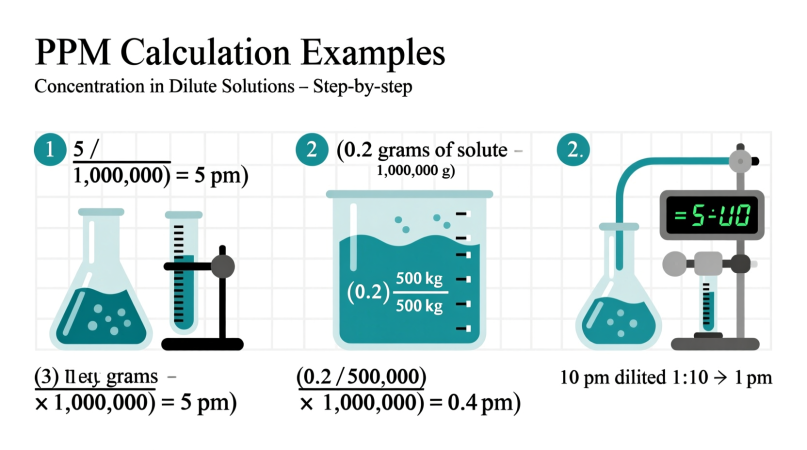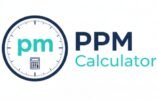
PPM Calculation Examples (10 Worked Problems) | Step-by-Step Solutions
Learning how to calculate parts per million (PPM) is an essential skill for anyone studying science, working in labs, or testing water, food, air, or soil quality. PPM allows us to describe very small concentrations in a way that’s easy to compare, understand, and communicate. In this guide, you’ll find 10 detailed, real-world PPM calculation examples—with step-by-step solutions to help you learn and practice with confidence.
1. Calculating PPM of Salt in Water
Problem:
You dissolve 3 mg of salt in 1 liter of water. What is the PPM concentration?
Solution:
Use the formula:PPM = (mg of solute) / (L of solution)
Plug in the numbers:
PPM = 3 mg / 1 L = 3 ppm
2. Measuring Nitrate in Well Water
Problem:
A water sample from a well contains 10 mg of nitrate in 2 liters of water. What is the nitrate concentration in PPM?
Solution:
PPM = 10 mg / 2 L = 5 ppm
3. Heavy Metals in Soil (mg/kg to PPM)
Problem:
A soil test finds 4 mg of lead in 1 kg of soil. What is the lead concentration in PPM?
Solution:
PPM = (mg of substance) / (kg of solid)
PPM = 4 mg / 1 kg = 4 ppm
4. Carbon Monoxide in Air (Volume to PPM)
Problem:
Air contains 2 mL of carbon monoxide in 1,000,000 mL of air. What is the concentration in PPM?
Solution:
PPM = (Volume of gas / Total volume) × 1,000,000
PPM = (2 / 1,000,000) × 1,000,000 = 2 ppm
5. Chlorine in Swimming Pool
Problem:
You add 15 mg of chlorine to 5 liters of pool water. What is the chlorine concentration in PPM?
Solution:
PPM = 15 mg / 5 L = 3 ppm
6. Dye Concentration After Dilution
Problem:
You dissolve 20 mg of dye in 250 mL of water. What is the PPM?
Solution:
Convert 250 mL to liters: 250 mL = 0.25 L
PPM = 20 mg / 0.25 L = 80 ppm
7. PPM to mg/L Conversion
Problem:
A water sample tests at 120 ppm calcium. How many mg/L is this?
Solution:
For water, 1 ppm = 1 mg/L
120 ppm = 120 mg/L
8. Summing PPM for Mixed Solutes
Problem:
You dissolve 10 mg of sugar and 6 mg of salt in 2 liters of water. What is the total PPM of dissolved solids?
Solution:
Total dissolved = 10 mg + 6 mg = 16 mg
PPM = 16 mg / 2 L = 8 ppm
9. PPM in Air by Mass
Problem:
A 10-liter air sample contains 0.005 grams of benzene vapor. What is the PPM by mass? (1 g = 1000 mg)
Solution:
Convert 0.005 g to mg: 0.005 g × 1000 = 5 mg
Assume air density ≈ 1 kg/m³ ⇒ 10 L = 0.01 m³ = 0.01 kg = 10,000 mg
PPM = (5 mg / 10,000 mg) × 1,000,000 = 500 ppm
10. PPM in Food (mg/kg)
Problem:
A food sample contains 0.5 mg of iron per 100 g. What is the PPM?
Solution:
Convert 100 g to kg: 100 g = 0.1 kg
PPM = 0.5 mg / 0.1 kg = 5 ppm
Tips for Accurate PPM Calculations
- Check your units: Always convert grams to milligrams, milliliters to liters, or grams to kilograms as needed.
- Use total final volume or mass: The denominator should always be the total solution or sample size.
- For water solutions: 1 mg/L is equal to 1 ppm—this makes quick calculations easy.
- For gases: Be sure to use the correct formula (by volume or mass).
If you need more help, explore the PPM Solution Calculator or MG/L to PPM Calculator.
For common errors, check out PPM Calculation Mistakes.

Dr. Robert is an industrial chemist specializing in process control, water purification, and quantitative chemical analysis. She has worked with environmental labs and manufacturing facilities to optimize solutions in parts-per-million (PPM) precision and safety compliance.
At PPMCalculator.com, Dr. Robert ensures the accuracy of each calculator and guide through peer review and data validation. Her mission is to make chemistry tools more reliable for engineers, researchers, and students worldwide.
Follow her professional updates on LinkedIn or contact via info@ppmcalculator.com. For More details, Click here
